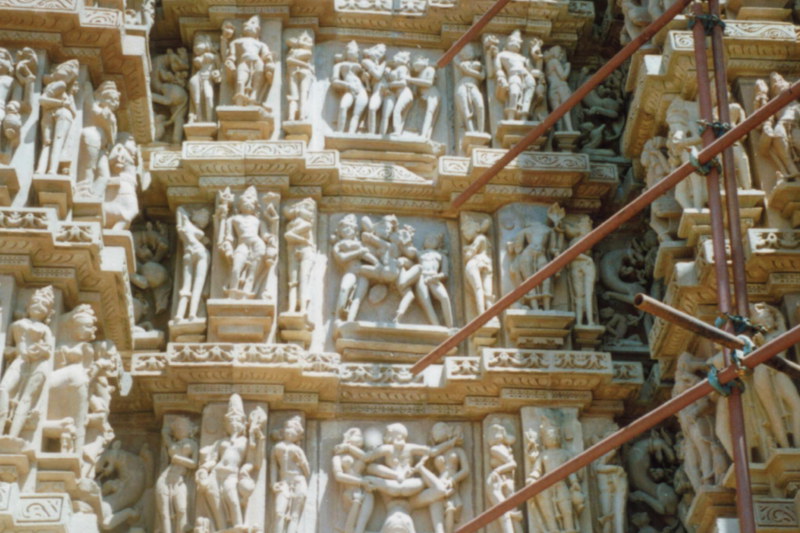The temples are an amazing work of art and well worth a journey! Erotica is one theme (and a reason why many visit) but the erotica is limited to the outside of the temples; the insides are reserved for deities, gods and scenes of everyday Indian life. The temples were built between 950 and 1050 by Chandela monarchs. Only 30% of the original temples remain and are in a somewhat good state.
There are a variety of theories as to why the temple carvings are so erotic and our guide had no shortage of these theories. He claimed at first they were temples built to appease the sex-craved god Indira; then he claimed that the population numbers of the Chandela were low so the temples were fitted with erotic sculptures to make the people procreate; then he said they were built as a sex manual for the youth. Who knows which is correct?
One common theme found on all the temples is the three different stages of erotica: The first stage was beginning sex, the second stage was intense faces or orgasm, and the third stage is of mellow faces of after sex. These three stages are seen as Mithuna or a term used in Tantra for sexual union in a ritual context to reach a higher connection and being. Many have said that the Khajuraho temples were built during a time when Tantra was common practice and seen as a way of reaching Nirvana.
The one carving that all the backpackers talked about is the carving of one man and his horse. The guide explained that after two years of maneuvers in the military men often “loved” their horse; the tour was a very frank one! Everyone gathered around to discuss the implications after they returned to the hotel.
As mentioned above, sex is not the only theme of the temples. Carvings of everyday life activities were also scattered throughout the temples and it is not uncommon to see images of musicians, dancers, the army, the royalty, the gods, and even the architects planning the temples! Below is a woman brushing her hair.
Gods are also prevalent. Vishnu and his incarnations are common, scenes from the Ramayana and the Mahabharata, and the Goddess Kali. The Devi Jagadambe Temple is dedicated to Kali/Parvotti. The guide said it was for Parvotti but all the sculpting outside the temple was of scenes of Kali drinking blood and being nasty. In the center is a sacrificial pit. Our guide explained that sacrifices were usually animals but there have been human sacrifices done in this temple. The most common means of killing a sacrifice was through fire (immolation), which meant a better life in the next incarnation.
As we wandered we could see archaeologists working diligently to try to clean all the temples. They use water and coconut palm brushes to wash away the black residue left over many years of neglect.
The Kandariya Mahadev is magnificent and has a honeycombed roof that looks like it is made of teakwood. It was built between 1025 and 1050, the main spire is 31m high, there are 226 statues inside the temple plus a further 646 outside. It is known for its carvings of energetic orgies.
This temple’s roof really impressed me and I got an excellent picture as we walked towards it (top). One particular tree which is seen in front of the temple will blossom in two weeks and these white blossoms are gathered by the locals and are made into wine. It is illegal to cut down one of these trees because the wine is so important to the locals.
The red-flowered tree that can be seen often from the train and in most villages is just a common tree. The wood from this tree is commonly used as firewood. There are other trees as well that have pod-like things growing on them. I was told by the guide that these are eucalyptus trees and in the summer kids open the pods and blow the cotton from inside into the air. Like Canadian kids do with dandelions.
